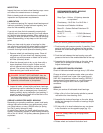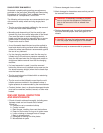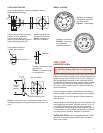
16
RIM/WHEEL PROBLEMS
RIM BASE CRACKS
Circumferential crack at back flange radius or bead set.
Causes: Overload and/or over inflation, damage due
to tire tools, tire bead deep pitting
or corrosion.
Circumferential cracks in
middle of rim.
Cause: Damage at valve slot
or elsewhere. Disc
weld problem.
Cracks in rim gutter.
Causes: Over inflation,
hammer damage,
or improper cleaning.
Butt weld projection.
Crack across mounting bevel
in a demountable rim.
Causes: Excessive clamping
torque or improper
components.
DISC FAILURES
Cracks at disc nave
and/or handhole.
Causes: Bad fit-up,
damaged hub, or
overload. Sharp
edge at handhole.
T
UBELESS RIM LEAKS.
Circumferential crack at
b
ead set.
Caused by pitting and
erosion by the tire bead.
Circumferential crack in
w
ell radius.
Caused by overload and
over inflation.
Circumferential crack at
attachment weld.
Caused by overload and
over inflation.
Note: Wheels with well-welded discs may not be
approved for use with radial tires.
Leak at butt weld caused
by cracked or damaged
weld.
Leak at valve hole.
Caused by damage or
severe corrosion.
Leak under tire bead,
groove or ridge across
bead seat.
Caused by corrosion, tire
tool marks, bent flange or other damage.
TIRE CHANGES
1. Check all metal surfaces as listed in the section
“Rim and Wheel Inspection and Maintenance.”
A more thorough check may be made, however,
after the tire has been demounted. Watch particularly
for the damages shown in this section, and refer to
recommendations if corrective measures are required.
NOTE: Openings between ends of split side rings
must not be less than 3/32" except where the ring
design calls for an abutting condition, or more than
5/16" after ring is seated in during operation. Split lock
rings used with endless side rings must not butt.
DANGER Be sure that replacements are made
with the proper sizes and types of rims and
rings.


















